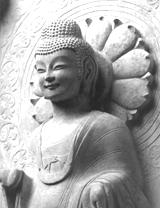 As a curator of the Poly Art Museum, Jiang Yingchun has his own temporary hide-away from the hustle and bustle of the office.
As a curator of the Poly Art Museum, Jiang Yingchun has his own temporary hide-away from the hustle and bustle of the office.
The quiet quarter, only a few strides away from his office, houses a special collection of around 40 rare Buddhist sculptures dated between the 5th and 9th centuries.
Entering the display room, one is greeted with gusts of fresh cool air and surrounded by dark, subdued walls.
Specially positioned tiny lime lights from the ceiling illuminate statues of Buddhas and bodhisattvas, which represent arguably the best works of Oriental Buddhist sculpture in Chinese history.
"I often stand still in front of a statue and look into the eyes of the Buddha," Jiang said. "I feel as if I am communicating with it from my heart."
Jiang can no longer keep the display room to himself as the Poly Art Museum will officially open the special collection to the public today.
But Jiang is not upset. "The public need to see what we have collected and we need to share the best ancient Chinese Buddhist sculptures with the public," he said.
It has taken Jiang, his colleagues and numerous renowned scholars - consultants to the Poly Art Museum - nearly a year to put together the special collection which strides through the Northern Wei (386-534), Eastern Wei (534-550), Northern Qi (550-577), Northern Zhou (557-581), Sui (581-618) and Tang (618-907) dynasties.
"The collection comprises diverse forms of sculpture including images carved against a background screen, steles and free-standing Buddha and bodhisattva images," Ren Jiyu, director of the National Library, noted.
A triad composed of Maitreya and two attendant bodhisattvas, dating back to the fourth year of the Zhengshi reign (507) of the Northern Wei, is the earliest known sculpture from Qingzhou with inscriptions.
Most of the works have come from Qingzhou in East China's Shandong Province, which is regarded as the best and largest center of Buddhist culture and sculpture between 4th and 6th centuries in China.
According to historical records, Faxian (335-420), the first Chinese Buddhist monk to travel to India in search of scriptures, stopped in Laoshan, in Qingdao, Shandong Province, in 412 on a voyage and stayed in Qingzhou for a year to translate and edit his scriptures and to preach.
Over the past 20 years, nearly 1,000 free-standing stone Buddhist statues have been unearthed in the area.
During their visit to Qingzhou in 1996, Jiang and other scholars were led to a newly excavated site about 8.7 meters long, 6.8 meters wide and 3.45 meters deep. Around 400 statues, many broken, were piled in layers in the ruins of the ancient Longxing Buddhist Temple.
"My first impression was amazement that this small cache could contain so many relics," Jiang said. "I also felt hurt that some of our ancient ancestors could be so cruel and ’thorough’ in destroying these artifacts."
Excepting one 118-centi-meter high sculpture of a standing Buddha with colored painting and applied gold, the selected works in the Poly Art Museum all suffered from the destruction of Buddhist culture in ancient Chinese history.
Some statues lost their fingers, or hands. The heads of the Buddha and two bodhisattvas, on a sculpture dedicated to Buddhism by Zhang Lingfei in the year 533 during the Northern Wei period, are all missing.
A 128-centimetre high bodhisattva, dating back to the Late Northern Wei and Eastern Wei periods (494-55), was broken into nine large pieces and numerous tiny pieces. The statue has been carefully pieced together and viewers can only discern the seams from the back of the statue.
Despite the losses, all the statues are well-preserved. Statues whose robes were once painted red and gold still bear visible patches of gold and mineral red color.
Buddhism was introduced in China in the late Han Dynasty (BC207-220AD). For nearly 300 years from the end of the Han Dynasty wars raged, especially in central and northern parts of China. Ravaged and torn by war, the people sought comfort in Buddhism, since the religion promised a happy afterlife if one performed his/her duties.
During the Northern and Southern (420-589) dynasties, royal and noble families took to Buddhism and donated large sums of money to Buddhist temples.
In particular they spent money commissioning artists to create Buddhist statues for the family, thus providing opportunities for pious Buddhist artists to make full use of their imagination and ingenuity.
Each of the almost 40 statues in the Poly Art Museum collection conveys a different expression. "Some give brilliant smiles while a few others appear more reserved and their smiles faint," Jiang said. "But I've found the ones with faint smiles seem to express more."
Scholars who participated in the job of putting the collection together have derived more historical facts from the statues.
Jin Weinuo, professor of art history with the Central Academy of Fine Arts, has been intrigued by the statues dating back to the Northern Qi which ruled northern China in the years between 550 and 577.
He noted that thin - almost see-through - silk robes, known as kasaya, were draped over the well-proportioned bodies of Buddhas from that time. Some kasayas have U-shaped incised lines to represent folds, but a few statues wear kasayas that flow down to the feet without a single crease.
Chinese kasayas were invariably thick and heavy, Jin said. The thin robes, distinctively more Indian than Chinese in style, suggested a revival of ethnic minority and foreign cultures arising in opposition to Han-ization under the rule of the Northern Wei.
At one time or another, Buddhist temples spread across the country along with millions of monks and nuns. The temples controlled land, employed servants and peasants and amassed enough power to begin to threaten the rule of emperors.
There followed a wide suppression of Buddhism and a destruction of Buddhist temples during the reigns of the Great Emperor Wudi (424-428) during the Northern Wei and of the Emperor Wudi (561-565) during the Northern Zhou.
Despite the devastation, Buddhism still thrived and was integrated into the lives of many Chinese.
The Poly Art Museum collection is small.
"We follow a policy of eschewing quantity and pursuing instead only the most precious, rare and finest examples," explained He Ping, president of the China Poly Group and director of the Poly Art Museum. "The Poly's staff have looked far and wide, and succeeded in acquiring a collection of the very best in ancient Chinese sculpture."
Small as the collection is, Jiang and his colleagues are ready to share it with the public.
"I hope more people will feel the solace and inspiration Buddha and the bodhisattva convey," Jiang said.
(China Daily 01/16/2001)
